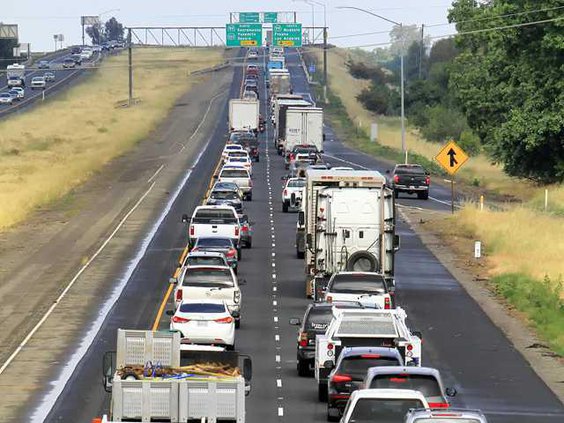The extra penny you pay every time you spend $2 on a taxable item in San Joaquin County is helping pay for a solution to ease the bottleneck at the Highway 120-99 interchange in a bid to slash the high volume of accidents plaguing the final eastern mile of the 120 Bypass.
Manteca Mayor Steve DeBrum and other regional leaders working with Caltrans to upgrade the interchange.
Caltrans got the process rolling. And because the San Joaquin Council of Government has the financial resources to do so thanks to the half cent countywide Measure K sales tax, they have retained a firm to handle the next phase of design work.
The goal is to have the alternatives examined, a design picked and environmental work done so construction on improvements could start as early as 2022.
However, DeBrum and other elected leaders have vowed to work with COG and Caltrans to accelerate that timetable to get work started sooner.
SJCOG is working with Caltrans with the tentative goal for plans and documents to be in place to capture future transportation funding with a Measure K match to have the work done by 2019.
SJCOG has also added a project to its list of targeted future endeavors to widen the 120 Bypass to six lanes at a cost of $95 million. The earliest that could happen currently is in 2040.
One of the designs being vetted for the interchange has two merge lanes going from the eastbound 120 Bypass onto southbound Highway 99. It also includes a flyover — much like from northbound Highway 99 to westbound Highway 4 (the Crosstown Freeway) in Stockton. It would allow traffic to make the transition at highway speed to reduce backups and congestion on northbound Highway 99.
The design would have both existing bypass lanes be able to take travelers south onto southbound Highway 99 with the inside lane also being able to go to Highway 99 north just like what exists today at the Crosstown Freeway.
407 significant Bypass
accidents in 5 years
Of the 407 accidents Manteca Fire responded to on the 120 Bypass from 2010 through 2015, 63 percent or 259 resulted in an injury. There were also nine deaths. Public safety personnel estimate when adding in fender benders — collisions where there was moderate damage to vehicles but no need for an ambulance — that number is easily doubled.
The bulk of those accidents are occurring between Main Street and Highway 99 on the eastbound lanes of the 120 Bypass.
The Measure K sales tax is what made possible the recently completed 10-mile project that widened Highway 99 and replaced the Lathrop Road and French Camp interchanges between Yosemite Avenue in Manteca and Arch Road in Stockton.
The second half of the project — widening and bridge work on Highway 99 from Arch Road to the Crosstown Freeway in Stockton should be completed next year.
“If it wasn’t for Measure K we wouldn’t have been able to leverage state money to do the widening project,” San Joaquin Council of Governments executive director Andrew Chelsey said last year. “Caltrans actually didn’t even have widening that segment on their radar.”
When SCOG approached Caltrans and offered to match Proposition 1B bond money for the freeway projects, the state reconsidered its stance. The end result was the decision to go forward with the $250 million project arguably years— if not decades — ahead of when it would have occurred if it had simply been programmed for improvements using state funds.
Not only having the money in hand thanks to the renewal of the Measure K half cent transportation tax in 2006 by 78 percent of the county’s voters make the project possible, but by moving forward when it did during an economic clump the $250 million cost of going from four to six lanes was whittled down to $145 million.
That cut SJCOG’s 35 percent share of the tab down to $50.75 million to effectively free up local funds to out toward other road improvements.
Measure K helped
SJ County get fifth
largest share of
$19.2 billion bond
When all was said and done, San Joaquin County claimed the fifth highest amount of the state $19.25 billion transportation bond securing $560 million for local projects leveraged with Measure K matching funds. The only counties securing more were Los Angeles ($1 billion), Alameda ($889 million), San Diego ($832 million), and Orange ($589 million).
Chesley said it is because of the Proposition 1B funds that Measure K matches that so many major road projects underway at the same time especially on Interstate 5 and Highway 99.
The Interstate 5 widening project north of Highway 4 to go from six to eight lane complete with the county’s first high occupancy vehicle lane that will have restricted use to those with two or more in the vehicle during commute hours is targeted for completion later this year.
Thirty percent of Measure K funds go to transit projects, 32.5 percent to congestion relief endeavors such as the freeway widening, 35 percent to local agencies for road projects and street maintenance, and 2.5 percent for railroad crossings safety projects.
Among South County projects Measure K funds have made possible are the widening of the 120 Bypass to four lanes, widening Interstate 205 to six lanes the Manteca transit station, the Altamont Corridor Express commute passenger service, widening Highway 99 from Manteca to the Stanislaus County line, the Jack Tone Road/Highway 99 interchange, the Lathrop Road railroad crossing, and the Tidewater Bikeway plus other endeavors.
Design starts on solution for Bypass



